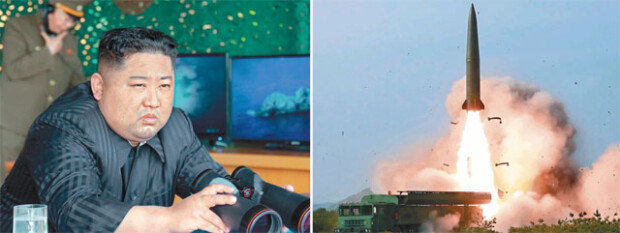Kim Jong Un launches missiles impossible to intercept
Kim Jong Un launches missiles impossible to intercept
Posted May. 06, 2019 08:54,
Updated May. 06, 2019 08:54

North Korea resumed provocative actions on Saturday for the first time in about 17 months by firing short-range missiles towards waters in the East Sea, which are believed to the “North Korean version of Iskander” that can dodge interception by the U.S. With Washington having warned “redirecting the path of its policy” towards the North, Pyongyang has started military protests by firing missiles, which constitutes violation of UN sanctions against the Stalinist country. Notably, North Korean leader Kim Jong Un said, “We should continue to step up struggles to strengthen our combat capabilities,” heralding additional provocations going forward. However, the Seoul government continued its low-key stance, in which it still pins hope for resumption of dialogue by maintaining its assessment of the North’s missiles as being “short-range projectiles.”
The North’s Korean Central News Agency reported on Sunday that Chairman Kim Jong Un guided in person live fire attack drills that were conducted in waters in the East Sea on Saturday. The official news agency identified the weapons used in the drills as “large-caliber long-range multiple rocket launchers” and “tactical guided weapons,” and publicized photos of firing scenes.
The new tactical guided weapons, which the North has identified, are believed to be an improved version of Russia’s Iskander missiles. The Iskander, which was developed by Russia to dodge interception by the U.S.’ terminal high-altitude area defense (THAAD) missile defense system, is a ballistic missile with a maximum range of 500 kilometers, and is capable of loading a nuclear warhead. The North’s tactical guided weapons, which are similar to Russia’s Iskandar just like twins, reportedly hit the target of rocky islets near Musudan-ri, Hwadae County, North Hamkyong Province, located about 240 kilometers away on Saturday.
If the missiles that Pyongyang fired are confirmed to be ballistic missiles, it constitutes violation of U.N. sanctions against Pyongyang. The U.N. Security Council adopted Resolution 1695 on sanctions against Pyongyang that bans the North from firing ballistic missiles irrespective of ranges, immediately after the North fired Taepo-dong 2 missiles in 2006.
“Through our analyses thus far, we have found that the North fired a number of shots with 240mm and 300mm short-range multiple rocket launchers including new tactical guided weapons,” the South Korean Defense Ministry said in a statement on Sunday. “We are closely examining if they were ballistic missiles or not.”
The South Korean military announced at around 9:30 a.m. on Saturday, “North Korea fired short-range missiles” before revising the announcement 30 minutes later by saying “the North fired several shots of short-range projectiles.” The military thus effectively switched its descriptions of the firing three times in two days from missiles to short-range projectiles to tactical guided weapons. “We urge Pyongyang to halt any acts that escalate military tension,” the presidential office said at a meeting of related ministers in lieu of a National Security Council meeting, and stated that “We hope that North Korea joins the efforts to resume dialogue sooner rather than later.”
President Trump tweeted Saturday, ”He also knows that I am with him & does not want to break his promise to me. Deal will happen.” He added however that “I believe that Kim Jong Un fully realizes the great economic potential of North Korea, & will do nothing to interfere or end it,” hinting that if Pyongyang continues provocations, he could terminate efforts to seek dialogue.
weappon@donga.com · hjson@donga.com







